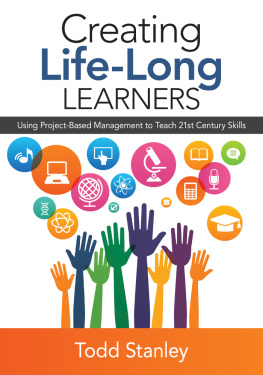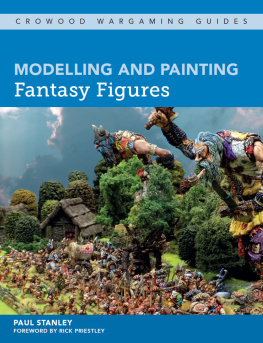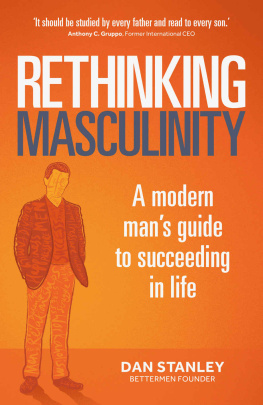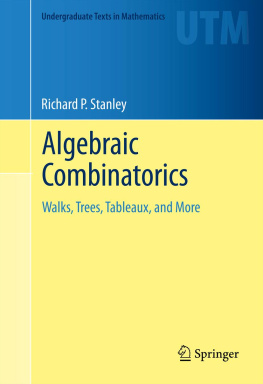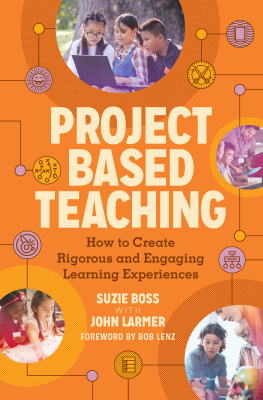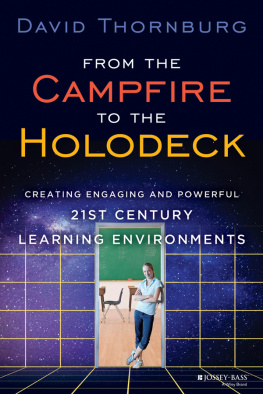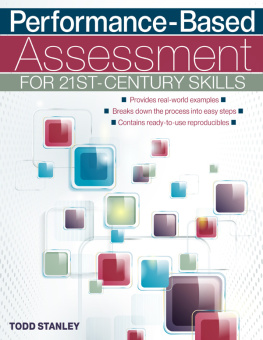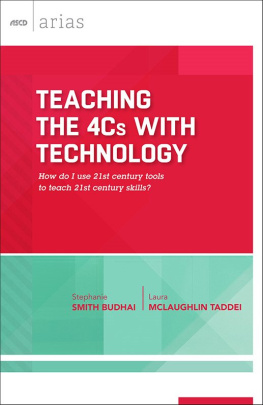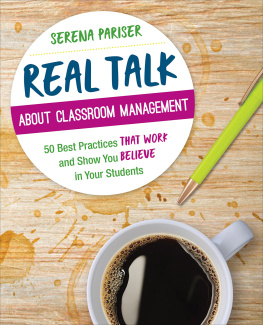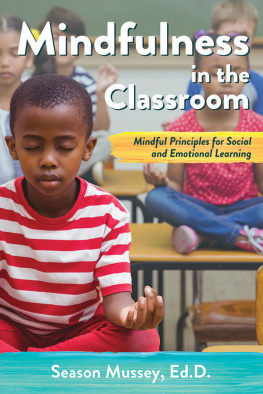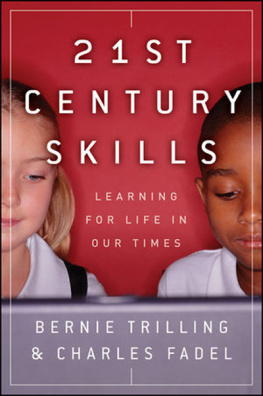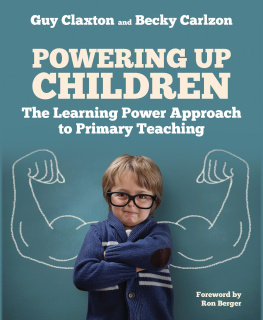Creating Life-Long Learners
Creating Life-Long Learners
Using Project-Based Management to Teach 21st Century Skills
For INFORMATION:
Corwin
A SAGE Company
2455 Teller Road
Thousand Oaks, California 91320
(800) 233-9936
www.corwin.com
SAGE Publications Ltd.
1 Oliver's Yard
55 City Road
London EC1Y 1SP
United Kingdom
SAGE Publications India Pvt. Ltd.
B 1/I 1 Mohan Cooperative Industrial Area
Mathura Road, New Delhi 110 044
India
SAGE Publications Asia-Pacific Pte. Ltd.
3 Church Street
#10-04 Samsung Hub
Singapore 049483
Copyright 2016 by Corwin
All rights reserved. When forms and sample documents are included, their use is authorized only by educators, local school sites, and/or noncommercial or nonprofit entities that have purchased the book. Except for that usage, no part of this book may be reproduced or utilized in any form or by any means, electronic or mechanical, including photocopying, recording, or by any information storage and retrieval system, without permission in writing from the publisher.
All trademarks depicted within this book, including trademarks appearing as part of a screenshot, figure, or other image, are included solely for the purpose of illustration and are the property of their respective holders. The use of the trademarks in no way indicates any relationship with, or endorsement by, the holders of said trademarks.
Printed in the United States of America
ISBN 978-1-4833-7719-3
This book is printed on acid-free paper.
Senior Acquisitions Editor: Jessica Allan
Senior Associate Editor: Kimberly Greenberg
Editorial Assistant: Cesar Reyes
Production Editor: Amy Schroller
Copy Editor: Lana Todorovic-Arndt
Typesetter: C&M Digitals (P) Ltd.
Proofreader: Jennifer Grubba
Indexer: Robie Grant
Cover Designer: Karine Hovsepian
Marketing Manager: Lisa Lysne

Acknowledgments
Corwin gratefully acknowledges the contributions of the following reviewers:
- Marsha Basanda
- Fifth-Grade Teacher
- Monarch Elementary School
- Simpsonville, SC
- Polly BeeBout
- Middle Science Teacher
- CY Middle School
- Casper, WY
- Avis Canty-Duck
- Special Education Teacher and Technology Facilitator
- Greenville County Schools
- Greenville, SC
- Marcia Carlson
- Sixth-Grade Teacher
- Crestview Elementary School
- Clive, IA
- Tamara Daugherty
- Art Teacher
- Lakeville Elementary School
- Apopka, FL
- Elaine Ealy
- Teacher/Adjunct Professor
- Crestwood Middle School
- Royal Palm Beach, FL
- Katina Keener
- Principal
- Achilles Elementary School
- Hayes, VA
- Debra K. Las
- Science Teacher
- Rochester Public Schools, ISD#535
- Rochester, MN
- Darron Laughland
- Special Education Teacher/Case Manager
- Kennett High School
- North Conway, NH
- Laurie McDonald
- Teacher
- Duval County Schools
- Jacksonville, FL
- Cathy Patterson
- Fifth-Grade Teacher; Former Assistant Principal
- Walnut Valley USD
- Walnut, CA
- Michelle Tavenner
- Sixth-Grade Teacher, Language Arts
- Gahanna Middle School East
- Gahanna, OH
- Dr. Karen L. Tichy
- Associate Superintendent for Instruction and Special Education
- Archdiocese of St. Louis
- St. Louis, MO
About the Author
Todd Stanleyis the author of seven teacher education books including
Project-Based Learning for Gifted Students: A Handbook for the 21st Century Classroom and
Performance-Based Assessment for 21st Century Skills. He has been a classroom teacher for the past 18 years and was a National Board Certified teacher. He helped create a gifted academy for Grades 58 where they employ inquiry-based learning, project-based learning, and performance-based assessment. He is currently a gifted intervention specialist for Reynoldsburg City Schools and lives in Pickerington, Ohio, with his wife Nicki and two daughters, Anna and Abby.
This book is dedicated to all the teachers past and present from the Gateway Gifted Academy who allowed me to grow as an educator and learn from the best.
IntroductionWhy Manage Your Classroom
We need to prepare students for THEIR future not OUR past.
Ian Jukes
There has been a push as of late in education to be teaching students what is termed 21st century skills. You might ask why this sudden focus on 21st century skills given that we are well over a decade into the 21st century. According to Thomas Friedman and his similarly titled book, it is because the world is becoming flat, that is, the world is not the gigantic place it once was. It was not that long ago that in order to correspond with someone overseas cheaply you had to write him or her a letter. If you were lucky, you could exchange four to five pieces of correspondence in a single year. With the advent of increased communications technology, it is not unreasonable to be connected with someone from any part of the world cheaply in seconds.
A lot has changed in just the last 30 years in the global community, and yet how much has changed in the way we teach our students? If someone were to invent a time machine and travel back 30 years to a school, how much different would it look? Sure you might be surprised at a blackboard as opposed to the white boards in most modern classrooms, but the class would probably still be taught in the same fashion with the teacher standing at the front giving the students information they will be tested on later. Why don't we update our methods of teaching along with everything else that has advanced in the past 30 years? Because it is comfortable to teach in this manner. It is the way we were taught and is the way we have been taught for hundreds of years. Why fix it if it ain't broke, as the saying goes. The problem is, recent statistics have shown, it may be broken.
Since we are on a more global playing field, it makes sense to compare students from the United States to students from other countries. So how does the United States stack up (Institute of Education Services, 2011)?
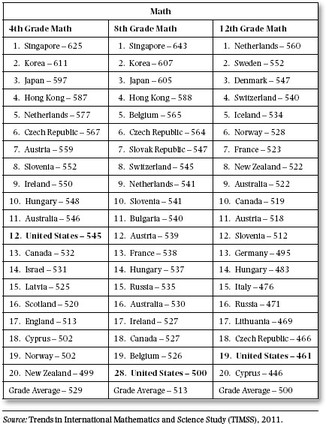
Source: Trends in International Mathematics and Science Study (TIMSS), 2011.
According to the Trends in International Mathematics and Science Study (TIMSS, 2011), not so good in mathematics. We are 28th with our eighth graders and near the bottom of the list for twelfth grade. In both, we are below the international average.

